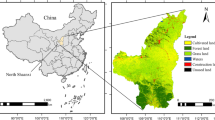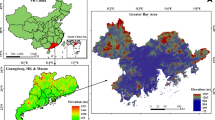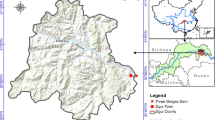Abstract
The exact roles of landscape fragmentation on sandy desertification are still not fully understood, especially with the impact of different land use types in spatial dimension. Taking patch size and shape into consideration, this paper selected the Ratio of Patch Size and the Fractal Dimension Index to establish a model that reveals the association between the area of bare sand land and the fragmentation of different land use types adjacent to bare sand land. Results indicated that (1) grass land and arable land contributed the most to landscape fragmentation processes in the regions adjacent to bare sand land during the period 1980 to 2010. Grass land occupied 54 % of the region adjacent to bare sand land in 1980. The Ratio of Patch Size of grass land decreased from 1980 to 2000 and increased after 2000. The Fractal Dimension Index of grass increased during the period 1980 to 1990 and decreased after 1990. Arable land expanded significantly during this period. The Ratio of Patch Size of arable land increased from 1980 to 1990 and decreased since 1990. The Fractal Dimension Index of arable land increased from 1990 to 2000 and decreased after 2000. (2) The Ratio of Patch Size and the Fractal Dimension Index were significantly related to the area of bare sand land. The role of landscape fragmentation was not linear to sandy desertification. There were both positive and negative effects of landscape fragmentation on sandy desertification. In 1980, the Ratio of Patch Size and the Fractal Dimension Index were negatively related to the area of bare sand land, showing that the landscape fragmentation and regularity of patches contributed to the expansion of sandy desertification. In 1990, 2000, and 2010, the Ratio of Patch Size and the Fractal Dimension Index were mostly positively related to the area of bare sand land, showing the landscape fragmentation and regularity of patches contributed to the reversion of sandy desertification in this phase. The absolute values of the coefficients were the highest for grass land in the regression models, so that grass land had the most important influence on sandy desertification.




Similar content being viewed by others
References
Alamusa, N. C., & Zong, Q. (2014). Temporal and spatial changes of freeze-thaw cycles in Ulan’aodu Region of Horqin Sandy Land, Northern China in a changing climate. Soil Science Society of America Journal, 78(1), 89–96.
Bagan, H., Takeuchi, W., Kinoshita, T., Yuhai, B., & Yamagata, Y. (2010). Land cover classification and change analysis in the Horqin Sandy Land from 1975 to 2007. Selected topics in applied earth observations and remote sensing. IEEE Journal of, 3(2), 168–177.
Bar Massada, A., Gabay, O., Perevolotsky, A., & Carmel, Y. (2008). Quantifying the effect of grazing and shrub-clearing on small scale spatial pattern of vegetation. Landscape Ecol, 23(3), 327–339.
Bogaert, J., Hecke, P. V., Eysenrode, D. S.-V., & Impens, I. (2000). Landscape fragmentation assessment using a single measure. Wildlife Society Bulletin, 28(4), 875–881.
Burgess, R. L. (1988). Community organization: effects of landscape fragmentation. Canadian Journal of Botany, 66(12), 2687–2690.
CCICCD, 2002. China national report on the implementation of the United Nation’s Convention to Combat Desertification.
Chang, X. L., Zhao, A. F., & LI, S. G. (1998). Effects of landscape in the desertification research. Joural of Desert Research, 18, 210–214.
Ci, L., Yang, X., 2010. Desertification and its control in China.
Corbane, C., Raclot, D., Jacob, F., Albergel, J., & Andrieux, P. (2008). Remote sensing of soil surface characteristics from a multiscale classification approach. CATENA, 75(3), 308–318.
Fan, C., & Myint, S. (2014). A comparison of spatial autocorrelation indices and landscape metrics in measuring urban landscape fragmentation. Landscape and Urban Planning, 121, 117–128.
Fu, B., Jones, K.B., 2013. Landscape ecology for sustainable environment and culture.
Galvin, K.A., Reid, R.S., Jr., R.H.B., Hobbs, N.T., 2005. Fragmentation in semi-arid and arid landscapes. Springer.
Han, Z., Wang, T., Yan, C., Liu, Y., Liu, L., Li, A., & Du, H. (2010). Change trends for desertified lands in the Horqin Sandy Land at the beginning of the twenty-first century. Environmental Earth Science, 59(8), 1749–1757.
Hanafi, A., & Jauffret, S. (2008). Are long-term vegetation dynamics useful in monitoring and assessing desertification processes in the arid steppe, southern Tunisia. Journal of Arid Environments, 72(4), 557–572.
Helldén, U., & Tottrup, C. (2008). Regional desertification: a global synthesis. Global and Planetary Change, 64(3–4), 169–176.
Hirche, A., Salamani, M., Abdellaoui, A., Benhouhou, S., & Valderrama, J. M. (2011). Landscape changes of desertification in arid areas: the case of south-west Algeria. Environmental Monitoring and Assessment, 179(1–4), 403–420.
Jaeger, J. G. (2000). Landscape division, splitting index, and effective mesh size: new measures of landscape fragmentation. Landscape Ecol, 15(2), 115–130.
Li, F. (1997). The theoretical analysis on the landscape ecological method application in desertification monitor. Arid Zone Research, 14, 69–73.
Li, X., & Zhang, H. (2015). Size distribution of dust aerosols observed over the Horqin Sandy Land in Inner Mongolia, China. Aeolian Research, 17, 231–239.
Li, S., Chang, Q., Peng, J., & Wang, Y. (2009). Indicating landscape fragmentation using L–Z complexity. Ecological Indicators, 9(4), 780–790.
Liu, H. J., Zhou, C. H., Cheng, W. M., Long, E. N., & Li, R. (2008). Monitoring sandy desertification of Otindag Sandy Land based on multi-date remote sensing images. Acta Ecologica Sinica, 28(2), 627–635.
Luo, F., Qi, S. Z., & Xiao, H. L. (2005). Landscape change and sandy desertification in arid areas: a case study in the Zhangye Region of Gansu Province, China. Environmental Geology, 49(1), 90–97.
Maestre, F. T., & Escudero, A. (2009). Is the patch size distribution of vegetation a suitable indicator of desertification processes? Ecology, 90(7), 1729–1735.
Mueller, E. N., Wainwright, J., & Parsons, A. J. (2007). The stability of vegetation boundaries and the propagation of desertification in the American Southwest: a modelling approach. Ecological Modelling, 208(2–4), 91–101.
Nagendra, H., Munroe, D. K., & Southworth, J. (2004). From pattern to process: landscape fragmentation and the analysis of land use/land cover change. Agriculture, Ecosystems & Environment, 101(2–3), 111–115.
Nams, V. O. (2012). Shape of patch edges affects edge permeability for meadow voles. Ecological Applications, 22(6), 1827–1837.
Qi, Y., Chang, Q., Jia, K., Liu, M., Liu, J., & Chen, T. (2012). Temporal-spatial variability of desertification in an agro-pastoral transitional zone of northern Shaanxi Province, China. CATENA, 88(1), 37–45.
Reynolds, J. F., Virginia, R. A., Kemp, P. R., Soyza, A. G. D., & Tremmel, D. C. (1999). Impact of drought on desert shrubs: effects of seasonality and degree of resource island development. Ecological Monographs, 69(1), 69–106.
Rodiek, J. (1988). The evolving landscape. Landscape and Urban Planning, 16(1–2), 35–44.
Rost, K. T., Böhner, J., & Pörtge, K.-H. (2003). Landscape degradation and desertification in the Mu Us Shamo, Inner Mongolia—an ecological and climatic problem since historical times? (Landschaftsdegradation und desertifikation in der Mu Us Shamo, Innere Mongolei—ein ökologisches und klimatisches problem seit historischer zeit?). Erdkunde, 57(2), 110–125.
Salinas, C. X., & Mendieta, J. (2013). Numerical model to assess the impact of the strategies to mitigate desertification. Mitig Adapt Strateg Glob Change, 18(5), 551–566.
Schlesinger, W. H., Raikes, J. A., Hartley, A. E., & Cross, A. F. (1996). On the spatial pattern of soil nutrients in desert ecosystems. Ecology, 77(2), 364–374.
Sun, D., Dawson, R., Li, H., & Li, B. (2005). Modeling desertification change in Minqin County, China. Environmental Monitoring and Assessment, 108(1–3), 169–188.
Sun, D., Dawson, R., Li, H., Wei, R., & Li, B. (2007). A landscape connectivity index for assessing desertification: a case study of Minqin County, China. Landscape Ecol, 22(4), 531–543.
Sun, D., Li, H., & Li, B. (2008). Landscape connectivity changes analysis for monitoring desertification of Minqin county, China. Environmental Monitoring and Assessment, 140(1–3), 303–312.
UNCCD, 2004. Preserving our common ground. UNCCD 10 Years on. United Nations Convention to Combat Desertification, Bonn, Germany.
Wang, T., & Zhu, Z. D. (2001). Studies on the sandy desertification in China. Chinese Jurnal of ECO-Agriculture, 9(2), 7–12.
Wang, T., Song, X., Yan, C., Li, S., & Xia, J. L. (2011). Remote sensing analyst on aeolian desertification trends in Northern China during 1975–2010. Journal of Desert Research, 31(6), 1351–1356.
Wang, T., Yan, C. Z., Song, X., & Xie, J. L. (2012). Monitoring recent trends in the area of aeolian desertified land using Landsat images in China’s Xinjiang region. ISPRS Journal of Photogrammetry and Remote Sensing, 68, 184–190.
Wu, Y., Liu, T., Pereira, L., Perards, P., & Wang, H. (2013). Validation and application of model ISAREG in a typical semiarid sand-meadow area of Horqin Sandy Land. In D. Li & Y. Chen (Eds.), Computer and computing technologies in agriculture VI (pp. 421–429). Berlin Heidelberg: IFIP Advances in Information and Communication Technology. Springer.
Xue, Z. J., Qin, Z. D., Li, H. J., Ding, G. W., & Meng, X. W. (2013). Evaluation of aeolian desertification from 1975 to 2010 and its causes in northwest Shanxi Province, China. Global and Planetary Change, 107, 102–108.
Yan, Q. L., Zhu, J. J., Hu, Z. B., & Sun, O. J. (2011). Environmental impacts of the shelter forests in Horqin Sandy Land, Northeast China. Journal of Environmental Quality, 40(3), 815–824. All rights reserved. No part of this periodical may be reproduced or transmitted in any form or by any means, electronic or mechanical, including photocopying, recording, or any information storage and retrieval system, without permission in writing from the publisher.
Zhang, Y., Ning, D., & Smil, V. (1996). An estimate of economic loss for desertification in China. China Population, Resources and Environment, 6, 45–49.
Zhang, G., Dong, J., Xiao, X., Hu, Z., & Sheldon, S. (2012). Effectiveness of ecological restoration projects in Horqin Sandy Land, China based on SPOT-VGT NDVI data. Ecological Engineering, 38(1), 20–29.
Acknowledgments
This article is supported by the Fundamental Research Funds for the Central Universities (Project 2662015JC001 and Project 2662015PY174). The authors would also like to thank the anonymous reviewers for their contribution to this article.
Author information
Authors and Affiliations
Corresponding author
Rights and permissions
About this article
Cite this article
Ge, X., Dong, K., Luloff, A.E. et al. Correlation between landscape fragmentation and sandy desertification: a case study in Horqin Sandy Land, China. Environ Monit Assess 188, 62 (2016). https://doi.org/10.1007/s10661-015-5039-8
Received:
Accepted:
Published:
DOI: https://doi.org/10.1007/s10661-015-5039-8




